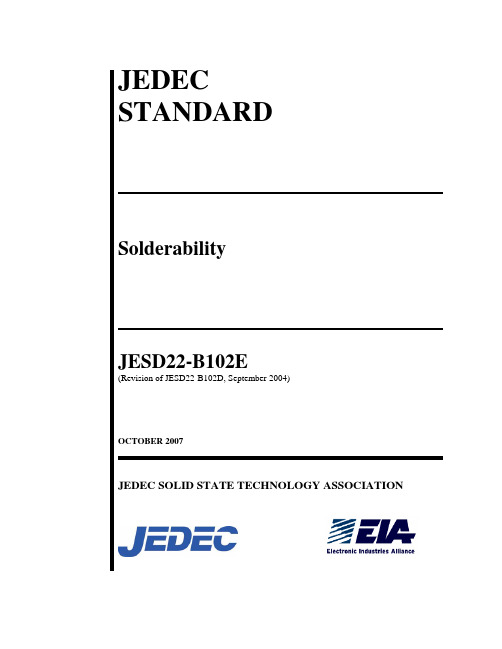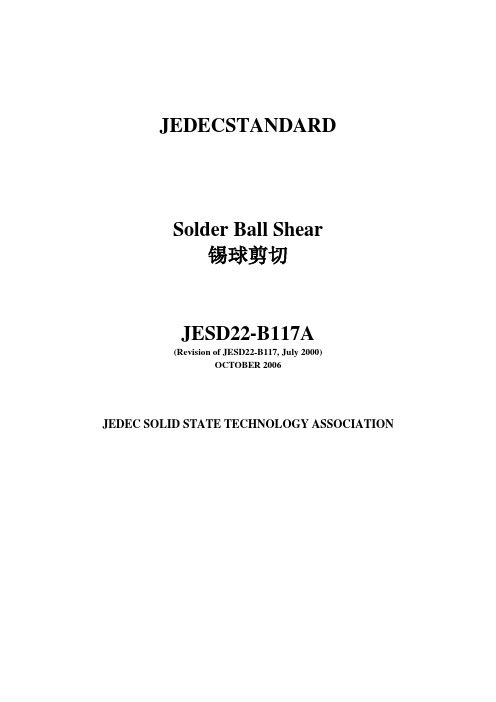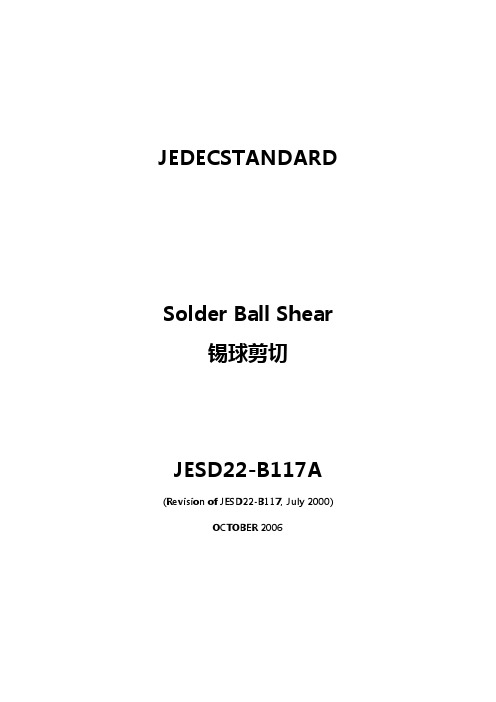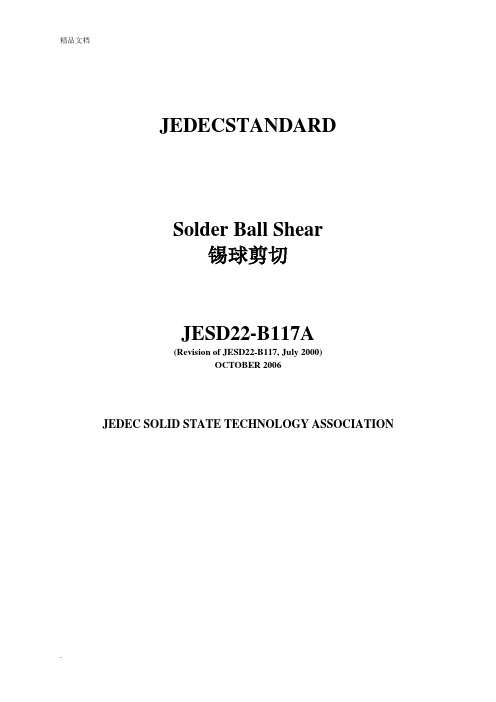JESD22-B117A Solder Ball Shear(锡球剪切力测试标准)
- 格式:pdf
- 大小:234.21 KB
- 文档页数:16


JEDECSTANDARDSolder Ball Shear锡球剪切JESD22-B117A(Revision of JESD22-B117, July 2000)OCTOBER 2006JEDEC SOLID STATE TECHNOLOGY ASSOCIATION测试方法B117:锡球剪切(从JEDEC委员会选票及JCB-06-37制定下,对包装设备的可靠性试验方法由JC-14.1小组委员会认定。
)1 范围这种测试方法适用于焊球结束前使用的附着物剪切力测试。
焊球分别剪切;力量和失效模式下的数据收集和分析。
在本文件包括低速和高速测试。
这个试验的目的是进行评估锡球能够承受机械剪切的能力,可能在器件制造、处理、检验、运输和最终使用的作用力。
焊料球剪切是一种破坏性试验。
2 术语和定义剪切力:适用于一个方向平行于设备平面到焊料球的力量。
测试仪器:测试仪器用于应用剪切力焊锡球。
剪切工具:一个刚硬的工具,直接对着在焊球剪切(见图1)。
剪切工具集成了传感元件,使剪切力可以测量。
剪切工具支架:设备平面和剪切工具刀之间的距离(见图1)。
夹具:剪切测试时夹具固定焊球在设备上(见图5)。
剪切速度:剪切刀具移动速率去剪焊锡球。
低速剪切:剪切速度通常是0.0001 - 0.0008米/秒(100 - 800微米/秒)。
高速剪切:剪切速度是一般为0.01 - 1.0米/秒,但可以超出这个范围。
回流后经过时间:焊球剪切和焊料球最后回流之间经过的时间。
失效模式:类型或锡球剪切后观察到的失效位置。
后压力测试:锡球剪切后进行可靠性评估,如温度循环或高温储存压力测试。
3 仪器剪切力测量设备应使用经过校准的传感器或传感元件。
应进行定期校准,以确保精度长期一致。
建议设备的最大负载能力至少为测量球在被测试部分的剪切最大值的10%。
该仪器可专门用于焊球剪切试验,或用于通用负载偏移量测试仪器。
该设备必须能够有施加到锡球的应用和记录。
该设备必须有能力用于一个已知位移速率的负载能力。

JEDECSTANDARDSolder Ball Shear锡球剪切JESD22-B117A (Revision of JESD22-B117, July 2000)OCTOBER 2006JEDEC SOLID STATE TECHNOLOGY ASSOCIATION测试方法B117:锡球剪切(从JEDEC委员会选票及JCB-06-37制定下,对包装设备的可靠性试验方法由JC-14.1小组委员会认定。
)1 围这种测试方法适用于焊球结束前使用的附着物剪切力测试。
焊球分别剪切;力量和失效模式下的数据收集和分析。
在本文件包括低速和高速测试。
这个试验的目的是进行评估锡球能够承受机械剪切的能力,可能在器件制造、处理、检验、运输和最终使用的作用力。
焊料球剪切是一种破坏性试验。
2 术语和定义剪切力:适用于一个方向平行于设备平面到焊料球的力量。
测试仪器:测试仪器用于应用剪切力焊锡球。
剪切工具:一个刚硬的工具,直接对着在焊球剪切(见图1)。
剪切工具集成了传感元件,使剪切力可以测量。
剪切工具支架:设备平面和剪切工具刀之间的距离(见图1)。
夹具:剪切测试时夹具固定焊球在设备上(见图5)。
剪切速度:剪切刀具移动速率去剪焊锡球。
低速剪切:剪切速度通常是0.0001 - 0.0008米/秒(100 - 800微米/秒)。
高速剪切:剪切速度是一般为0.01 - 1.0米/秒,但可以超出这个围。
回流后经过时间:焊球剪切和焊料球最后回流之间经过的时间。
失效模式:类型或锡球剪切后观察到的失效位置。
后压力测试:锡球剪切后进行可靠性评估,如温度循环或高温储存压力测试。
3 仪器剪切力测量设备应使用经过校准的传感器或传感元件。
应进行定期校准,以确保精度长期一致。
建议设备的最大负载能力至少为测量球在被测试部分的剪切最大值的10%。
该仪器可专门用于焊球剪切试验,或用于通用负载偏移量测试仪器。
该设备必须能够有施加到锡球的应用和记录。
该设备必须有能力用于一个已知位移速率的负载能力。

测试方法B101 外观检查1. 目的本测试的目的是验证材料、设计、施工、标记和设备的工艺应符合采购文档要求的适用性。
外部目测是一种无损检测方法,适用于所有包装类型。
该测试适用于鉴定、过程、监控或批量验收两者都有。
2.仪器在本测试中使用的设备应能够证明设备符合要求。
3.过程设备应按照适用的要求进行检验采购文件及第4条所列的准则。
当外国材料有问题时,设备可能受到干净的过滤气流(吸力或每秒88英尺,最大,并重新检查。
4. 失败的标准设备有下列情形之一的,视为故障:(a)设备设计、引线标识、标记(内容、位置和易读性)、材料、构造和工艺与采购文档不一致;(b)明显的腐蚀、污染或破损迹象[严重弯曲或破损]、引线、破裂密封(玻璃半月板除外)、有缺陷(剥落、剥落或起泡)或损坏的电镀或裸露的金属基底。
(由剥落、点蚀或腐蚀引起的成品变色);(c)不完整或与未与正常位置对齐的引脚;非正常的引脚弯曲;以及(对于带状引脚)扭曲超过了正常引脚平面之外;(d)有任何不符合详图或适用采购文件的情况,或有任何会影响设备的正常使用的未知特性、损坏、腐蚀或污染的情况。
(e)因制造、搬运、测试或下列原因造成的缺陷或损坏:(1)包装破损。
表面划伤不应成为失效原因,除非它们违反了本协议规定的标记、表面处理等其他标准。
(2)任何在表面任何方向上超过0.060英寸(1.52毫米)以及表面损伤深度超过受影响元件厚度25% (上盖、底托或侧面) 的情况。
(3)任何暴露密封玻璃(在此之前未暴露)或任何设计不打算暴露的引线框材料的缺口。
5.总结下列细节应在适用的采购文件中说明:(a)标记和引线或引脚识别的要求(见4.)。
(b)材料、设计、施工和工艺的详细要求(见4.)。
(c)样本量和质量等级。

JESD22标准定义及意义详细如下JESD22-A101orJESD22-A110.3. A101稳态温湿度偏置寿命JESD22-A101-BPublished:Apr-1997STEADY-STATETEMPERATUREHUMIDITYBIASLIFETEST: Thisstandardestablishesadefinedmethodandconditionsf orperformingatemperaturehumiditylifetestwithbiasapplied.Thetestisusedtoevaluatethereliabilityofnonhermeticpackagedsolidstatedevicesinhumidenvironments.Itemployshightem peratureandhumidityconditionstoacceleratethepenetrati onofmoisturethroughexternalprotectivematerialoralongi nterfacesbetweentheexternalprotectivecoatingandcondu ctorsorotherfeatureswhichpassthroughit.Thisrevisionen hancestheabilitytoperformthistestonadevicewhichcanno tbebiasedtoachieveverylowpowerdissipation.JESD22-A101-B发布:1997 年8 月稳态温湿度偏置寿命试验本标准建立了一个定义的方法,用于进行一个施加偏置电压的温湿度寿命试验。
本试验用于评估非气密封装固态器件在潮湿环境下的可靠性。
试验采用高温和高湿条件以加速水汽对外部保护材料或沿着外部保护材料和外部保护涂层,贯通其的导体或其他部件的穿透作用。

JEDECSTANDARDSolder Ball Shear锡球剪切JESD22-B117A(Revision of JESD22-B117, July 2000)OCTOBER 2006JEDEC SOLID STATE TECHNOLOGY ASSOCIATION测试方法B117:锡球剪切(从JEDEC委员会选票及JCB-06-37制定下,对包装设备的可靠性试验方法由JC-14.1小组委员会认定。
)1 范围这种测试方法适用于焊球结束前使用的附着物剪切力测试。
焊球分别剪切;力量和失效模式下的数据收集和分析。
在本文件包括低速和高速测试。
这个试验的目的是进行评估锡球能够承受机械剪切的能力,可能在器件制造、处理、检验、运输和最终使用的作用力。
焊料球剪切是一种破坏性试验。
2 术语和定义剪切力:适用于一个方向平行于设备平面到焊料球的力量。
测试仪器:测试仪器用于应用剪切力焊锡球。
剪切工具:一个刚硬的工具,直接对着在焊球剪切(见图1)。
剪切工具集成了传感元件,使剪切力可以测量。
剪切工具支架:设备平面和剪切工具刀之间的距离(见图1)。
夹具:剪切测试时夹具固定焊球在设备上(见图5)。
剪切速度:剪切刀具移动速率去剪焊锡球。
低速剪切:剪切速度通常是0.0001 - 0.0008米/秒(100 - 800微米/秒)。
高速剪切:剪切速度是一般为0.01 - 1.0米/秒,但可以超出这个范围。
回流后经过时间:焊球剪切和焊料球最后回流之间经过的时间。
失效模式:类型或锡球剪切后观察到的失效位置。
后压力测试:锡球剪切后进行可靠性评估,如温度循环或高温储存压力测试。
3 仪器剪切力测量设备应使用经过校准的传感器或传感元件。
应进行定期校准,以确保精度长期一致。
建议设备的最大负载能力至少为测量球在被测试部分的剪切最大值的10%。
该仪器可专门用于焊球剪切试验,或用于通用负载偏移量测试仪器。
该设备必须能够有施加到锡球的应用和记录。
该设备必须有能力用于一个已知位移速率的负载能力。
JEDECSTANDARDMechanical Shock – Component and SubassemblyJESD22-B110B(Revision of JESD22-B110A, November 2004, Reaffirmed: June 2009)JULY 2013JEDEC SOLID STATE TECHNOLOGY ASSOCIATIONNOTICEJEDEC standards and publications contain material that has been prepared, reviewed, and approved through the JEDEC Board of Directors level and subsequently reviewed and approvedby the JEDEC legal counsel.JEDEC standards and publications are designed to serve the public interest through eliminating misunderstandings between manufacturers and purchasers, facilitating interchangeability and improvement of products, and assisting the purchaser in selecting and obtaining with minimum delay the proper product for use by those other than JEDEC members, whether the standard is tobe used either domestically or internationally.JEDEC standards and publications are adopted without regard to whether or not their adoption may involve patents or articles, materials, or processes. By such action JEDEC does not assume any liability to any patent owner, nor does it assume any obligation whatever to parties adoptingthe JEDEC standards or publications.The information included in JEDEC standards and publications represents a sound approach to product specification and application, principally from the solid state device manufacturer viewpoint. Within the JEDEC organization there are procedures whereby a JEDEC standard or publication may be further processed and ultimately become an ANSI standard.No claims to be in conformance with this standard may be made unless all requirements stated inthe standard are met.Inquiries, comments, and suggestions relative to the content of this JEDEC standard or publication should be addressed to JEDEC at the address below, or refer to under Standards and Documents for alternative contact information.Published by©JEDEC Solid State Technology Association 20133103 North 10th StreetSuite 240 SouthArlington, VA 22201-2107This document may be downloaded free of charge; however JEDEC retains thecopyright on this material. By downloading this file the individual agrees not tocharge for or resell the resulting material.PRICE: Contact JEDECPrinted in the U.S.A.All rights reservedPLEASE!DON’T VIOLATETHELAW!This document is copyrighted by JEDEC and may not bereproduced without permission.For information, contact:JEDEC Solid State Technology Association3103 North 10th StreetSuite 240 SouthArlington, VA 22201-2107or refer to under Standards-Documents/Copyright Information.JEDEC Standard No. 22-B110BPage 1TEST METHOD B110BMECHANICAL SHOCK– COMPONENT AND SUBASSEMBLY(From JEDEC Board Ballot JCB-13-27, formulated under the cognizance of the JC-14.1 Subcommittee on Reliability Test Methods for Packaged Devices.)1 ScopeComponent and Subassembly Mechanical Shock Test Method is intended to evaluate components in the free state and assembled to printed wiring boards for use in electrical equipment. The method is intended to determine the compatibility of components and subassemblies to withstand moderately severe shocks. The use of subassemblies is a means to test components in usage conditions as assembled to printed wiring boards. Mechanical Shock due to suddenly applied forces, or abrupt change in motion produced by handling, transportation or field operation may disturb operating characteristics, particularly if the shock pulses are repetitive. This is a destructive test intended for component qualification.2 ApparatusThe shock-testing apparatus shall be capable of providing shock pulses with a peak acceleration of up to 2900 multiples of gravity (g), a velocity change of 100 to 544 centimeters per second (39 to 214 inches per second), and a pulse duration between 0.3 and 8.0 milliseconds to the body of the component. For free-state testing, a velocity change of 125 to 544 centimeters per second (49 to 214 inches per second) and a pulse duration between 0.3 and 2.0 milliseconds is sufficient. Conversely, for mounted-state testing, apparatus capable of a velocity change of 100 to 544 centimeters per second (39 to 214 inches per second) and a pulse duration between 5.0 and 8.0 milliseconds to the body of the component is sufficient.The acceleration pulse shall be a half-sine waveform with an allowable deviation from specified peak acceleration not greater than ±10%. The test velocity change shall be ±10% of the specified level. The pulse duration shall be measured between the points at 10% of the peak acceleration during rise time and 10% of the peak acceleration during decay time. Absolute tolerances of the pulse duration shall be ±15% of the specified duration. The test equipment transducer shall have a natural frequency greater than 5 times the frequency of the shock pulse being established, and measured through a low-pass filter having a bandwidth greater than 5 times the frequency of the shock pulse being established. Filtering should not be used in lieu of good measurement setup and procedure practices.Appropriate equipment calibration should be considered prior to any testing to ensure conformance to the specified targets and acceptable tolerances. Reserving a set of known good units is recommended for pre-test calibration exercise whenever new samples are to be tested. If calibration tests are conducted regularly, then following periodical preventive maintenance should suffice for the equipment to meet the target and tolerance limits.Test Method B110B(Revision of Test Method B110A)JEDEC Standard No. 22-B110BPage 23 Terms and definitionsc omponent: A constituent part.NOTE 1 Examples include integrated circuits as attached components and surface-mounted-subassembly components of printed circuit boards.NOTE 2 The classification of an item as a device or a component depends upon the intention of the owner at the time of classification.dead-bug (orientation): The orientation of a package with the terminals facing up.deviation from specified acceleration [velocity change] [pulse duration] level: The maximum difference between the measured value and the target value.equivalent drop height: The free-fall drop height from which an object at rest must fall, in vacuum, under standard gravity, to attain a velocity equal to the velocity change stated in the test specification. NOTE This is the theoretical height that will impart the specified velocity change if impact with zero rebound occurs. This height is provided for reference only in the various service conditions.free state (of a component): The state in which a component or subassembly is rigidly attached to the test apparatus so that the full specified shock level is transmitted to the component or subassembly body. live-bug (orientation): The orientation of a package with the terminals facing down , e.g., resting on its terminals.mounted state: The state in which a subassembly is supported by a test fixture that allows flexure to simulate usage conditions and in a manner such that the full specified shock level is transmitted to the subassembly body.peak acceleration: The maximum acceleration during the dynamic motion of the sample under test.pulse duration: The time interval between the instant when the acceleration first reaches 10% of its specified peak level and the instant when the acceleration first returns to 10% of the specified peak level after having reached that peak level.NOTE The basic frequency of the pulse is 1/ (2 x duration).service condition: The designation for the severity of stress.subassembly: A printed circuit board and the components assembled thereon that form a unit or segment of electrical equipment.NOTE The components are preferably located near the center of the printed circuit board.velocity change: The integral of the acceleration interval over the duration of the entire shock event including at least the pulse duration interval.vertical direction: The direction that is parallel with gravity, i.e., normal to the normalized surface of the earth.Test Method B110B(Revision of Test Method B110A)4 PThe shock before us apparatus to a total duration s directions subassemb accelerati in each of 2 define thThere are a componCompone In the free full specif is perform componen a process such proc Procedure k-testing appa e. Means sha . In the free sof 30 shocksspecified in ts of three orth bly shall be on, velocity c f the positive he componen Figu Figure 2two types of nent or subass ents or s ubas e-state, the co fied shock lev med, the meth nt or subassem or processes esses in the te aratus shall b all be provide state unless o s, which are f the selected s hogonal axes subjected to change and p and negative nt orientation, re 1 — Live facing d 2 — Dead b facing u f tests that can embly in the ssemblies sub omponent or vel is transmi hod of moun mbly rework,should be apest hardware be attached to ed to prevent otherwise spe five shock pu service condi s (X, Y and Z o a total of pulse duration e directions of positive and bug orientat ownward in bug orientat pward in ei n be performe free-state, an bjected to the subassembly itted to the co nting to the t reuse, remou pplied to the cpreparation s o a sturdy lab t the shock f cified, the co ulses of the p ition (see Tab Z). If shock t 12 shocks, n specified in f three orthog negative dire tion with sold either free o tion with sol ither free or ed, based on t nd another is t test shall be r shall be rigid omponent or est apparatus unting, burn i component orhall be docum A1A1 boratory table from being re omponent or peak accelerat ble 1) in eac testing is req which are t the selected gonal axes (X ections for the der spheres o or mounted sRotalive-b lder sphere r mounted s the test inform testing of a su randomly sel dly attached t subassembly s shall be typ in, or other str r subassembly mented.JEDEC Stan (Revision of T e or equivalen epeated due t subassembly tion, velocity ch of the pos quired in the two shock p service cond X, Y and Z). F e three orthogof componen state.ate clockwise bug to dead-b es of compon state.mation needed ubassembly in ected and typ to the test app y body. If the pical of the u ressful proces y prior to the ndard No. 22-B P Test Method B Test Method B nt base and le to “bounce” i shall be subj y change and sitive and neg mounted stat ulses of the dition (see Tab Figure 1 and F gonal axes. nt– bugnentd. One is testi n a mounted-s pical of produ paratus, so th mounted stat usage conditi ss is possible e shock test. U B110BPage 3B110B110A)eveled in thejected pulse gative te, the peak ble 2) Figure ing ofstate. uction. hat the te test ion. If , such Use ofJEDEC Standard No. 22-B110BPage 4Test Method B110B(Revision of Test Method B110A)4.1 Component or subassembly in free-stateComponents or subassemblies to be tested in the free- state must be subjected to at least one of the service conditions (A to H) shown in Table 1, which shall be documented. The designated shock shall be applied to the component or subassembly body in a manner to simulate expected impacts during processing, packaging, and shipment. The component or subassembly shall be rigidly attached to the test apparatus in such a manner that it experiences the full-specified shock level at the component or subassembly body. At least five shocks in each of two directions of three orthogonal axes shall be applied (minimum total of 30 shocks) at the severity of the designated service condition.Table 1 — Component or subassembly free state test levelsNOTE velocity change = 2 * (std_g * acceleration_peak_g * pulse_duration) / pidrop height = 0.5 * (velocity_change)2 / std_g4.2 Subassembly in mounted stateIf required, subassemblies shall also be tested in a mounted state, subject to at least one of the service conditions (1 to 14) shown in Table 2, which shall be documented. The designated shock shall be applied to the subassembly mounted to the test apparatus with fixtures that allow flexure to simulate the usage conditions, and in a manner such that the full specified shock level is transmitted to the subassembly body. Preferred methods to support the subassembly are a slotted/clamping 'picture frame', or a raised-boss bolted fixture with contact points in four regions not closer than one inch from any component. The subassembly, supporting method, test fixture mounting dimensions, and one or more of the lowest resonant frequencies of the subassembly shall be documented. At least two shocks in each of two directions of three orthogonal axes shall be applied (minimum total of 12 shocks) at the severity of the designated service condition.The optimum test is performed when the subassembly is mounted in a manner that simulates the application configuration. If that information is unknown or unavailable, a recommended printed wiring board for testing the component(s) of the subassembly is the JEDEC standard thermal card (as described in JEDEC Standards JESD51-9, JESD51-10, and JESD51-11), which should be modified to include component and connection functionality circuitry.ServiceconditionAcceleration peak Pulse duration Velocity change Equivalent drop height g ms cm/s in/s cm inches H2900 0.3 543 214 150 59 G2000 0.4 499 197 127 50 B 1500 0.5 468 184 112 44F 900 0.7 393 155 78.9 31A 500 1.0 312 123 49.7 20E 340 1.2 255 100 33.1 13D 200 1.5 187 73.7 17.9 7C 100 2.0 125 49.2 7.90 3JEDEC Standard No. 22-B110BPage 5Test Method B110B(Revision of Test Method B110A)4.2 Subassembly in mounted state (cont’d)Alternately, if the size or construction of the JEDEC thermal card is not suitable for the given component(s), a printed wiring board should be used with the dimensions, materials, and construction typical for the component subassembly usage, and should include electrical circuitry to test for functionality, continuity, and damage of the component on the subassembly. The dimensions and construction of the printed wiring board shall be documented. Test results using subassembly application hardware are most relevant and should take precedence over results obtained using test vehicles. Table 2 — Subassembly mounted state test levelsServiceconditionAcceleration peak Pulse duration Velocity change Equivalent drop height g ms cm/s in/s cm inches 1109 8.0 544 214 151 60 2108 7.5 506 199 130 51 3 107 7.0 468 184 111 444 105 6.5 426 168 92.6 365 103 6.0 386 152 75.9 306 95 5.8 344 135 60.3 247 86 5.6 301 118 46.1 188 72 5.4 243 95.6 30.0 129 67 5.3 222 87.3 25.1 1010 61 5.2 198 78.0 20.0 811 54 5.1 172 67.7 15.1 612 45 5.0 140 55.3 10.1 413 39 5.0 122 47.9 7.6 314 32 5.0 100 39.3 5.1 2NOTE velocity change = 2 * (std_g * acceleration_peak_g * pulse_duration) / pidrop height = 0.5 * (velocity_change)2 / std_g4.3 MeasurementsHermeticity tests, if required, visual examination and electrical measurements (consisting of parametric and functional tests) shall be performed.JEDEC Standard No. 22-B110BPage 6Test Method B110B(Revision of Test Method B110A) 5 Failure criteriaA component or subassembly shall be considered as a failure if hermeticity requirements, if any, cannot be demonstrated, if parametric limits are exceeded or if functionality cannot be demonstrated under the conditions specified in the applicable procurement document. Mechanical damage, such as cracking, chipping or breaking of portions of the component shall also be considered a failure provided such damage was not caused by fixturing or handling and the damage is critical to performance in the specific application. Subassembly failure criteria may include, but is not limited to, solder connections to the printed wiring board, compliant pin leads, adhesive, encapsulation, or underfill that materially affect component or subassembly reliability.6 SummaryThe following details shall be specified in the applicable procurement document:a) Test service condition, for each test performed.b) Electrical measurements.c) Sample size and accept number.d) Disposition of failures.e) Hermetic leak rate (if applicable).f) Description of mounted state test vehicle and fixture (if applicable).g) Description of component pre-test stress history (if applicable).JEDEC Standard No. 22-B110BPage 7 Annex A (informative) Differences between JESD22-B110B and JESD22-B110AA.1 Differences between JESD22-B110B and JESD22-B110AThe following list briefly describes most of the changes made to entries that appear in this publication, JESD22-B110B, compared to its predecessor, JESD22-B110A (November 2004, reaffirmed June 2009). Clause Description of ChangeAll Combined Mechanical Shock JESD22-B104C into this standard to establish one document covering unattached components and components attached to printed wiring boards.2 Modified tolerance limits: peak acceleration reduced from ±20% to ±10%; pulse duration reduced from ±30% to ±15%.3 Updated Terms and definitions.4 Added Figures 1 and 2.4.1 Updated Table 1: mathematical formulas added for velocity change and equivalent drop height; calculated values shown in table.4.2 Updated Table 2: mathematical formulas added for velocity change and equivalent drop height; calculated values shown in table; portable subassembly conditions removed.JEDEC Standard No. 22-B110B Page 8StandarThe purporegarding JEDEC. AIf you canJEDEC Attn: Publ 3103 Nort Suite 240Arlington,1. I reco RT The r UO2. Reco3. OtherSubmitted Name: Company Address:City/Staterd Improve ose of this fo usage of the All comments n provide inpu lications Depa th 10thStreet SouthVA 22201-2ommend chan Requirement,Test method referenced cla UnclearOther mmendations r suggestions d by y:e/Zip: ement Form orm is to prov e subject sta s will be collec ut, please com artment2107nges to the fo , clause numbnumber ause number Too Rigid s for correctio s for documenm vide the Tech andard. Indiv cted and disp mplete this for llowing: berhas proven to In Eon: nt improveme hnical Commit viduals or com persed to the a rm and return Fax: 70Clause numb o be:Error nt:JEDE ttees of JEDE mpanies are appropriate c to:03.907.7583ber Phone:E-mail:Date:EC JESD2EC with inpu invited to su committee(s). 22-B110Bt from the ind ubmit comme dustry nts to。
电子封装锡和锡合金表面晶须标准研究发布时间:2022-05-09T08:14:17.102Z 来源:《新型城镇化》2022年9期作者:杨雅丽曲乐[导读] 本文简述了晶须的来源,形成机理及抑制措施,并结合JEDEC的标准对锡晶须标准制定进行指导。
珠海格力电器股份有限公司广东珠海 519000摘要:在当前电子封装行业,锡和锡合金易于产生锡须致使电器发生故障是一直以来困扰的难题,随着环保要求的提高,在锡中添加铅可以抑制锡晶须的生长已经不再是解决这一难题的绝佳方案,因此对锡晶须标准的研究成为必不可少的课题。
本文简述了晶须的来源,形成机理及抑制措施,并结合JEDEC的标准对锡晶须标准制定进行指导。
1引言锡和锡合金由于本身物理特性,易于在表面形成晶须致使电器发生故障,这一现象严重阻碍了电子封装行业的发展,尤其在航空航天、军事等高精端应用场景中,这一难题始终悬而未决。
而在实际应用过程中,针对晶须建立相关标准对于评价其使用性能尤为重要,因此对晶须的标准研究也是电子封装中必不可少的课题。
本文结合JESD22-A121A和JESD201A标准,即锡和锡合金表面晶须生长测量的测试方法、锡和锡合金表面涂层的锡须灵敏度环境验收要求,深入对锡晶须标准分析研究。
2晶须来源晶须是指一种呈纤维状的晶体,均匀的横截面积是其主要特征。
锡晶须则是在锡或锡合金表面自发生长出的晶须。
电子器件使用过程中晶须的存在造成相邻导体间短路、晶须短路导致金属蒸发放电等。
晶须的形成机理一直是业界研究的重点也是难点问题,目前尚无公认一致的结论。
目前提出的生长机制主要有位错机制、再结晶机制、氧化膜破裂(COT)机制、金属间化合物氧化分解机制、氢致晶须生长机制5种。
基于对晶须生长机制的探讨研究,提出了合金化、去应力退火[1]、中间隔离层、镀后重熔[2]、有机涂层、电镀工艺改进等几种锡晶须的抑制措施。
尽管目前除添加铅元素外还发现一些抑制锡晶须的措施,但仍无可量产并实现产业性抑制晶须的措施,锡晶须的产生无可避免,因此亟需建立对电子元器件中锡晶须的标准要求。
JESD22-B101中文版测试方法B101 外观检查1. 目的本测试的目的是验证材料、设计、施工、标记和设备的工艺应符合采购文档要求的适用性。
外部目测是一种无损检测方法,适用于所有包装类型。
该测试适用于鉴定、过程、监控或批量验收两者都有。
2.仪器在本测试中使用的设备应能够证明设备符合要求。
3.过程设备应按照适用的要求进行检验采购文件及第4条所列的准则。
当外国材料有问题时,设备可能受到干净的过滤气流(吸力或每秒88英尺,最大,并重新检查。
4. 失败的标准设备有下列情形之一的,视为故障:(a)设备设计、引线标识、标记(内容、位置和易读性)、材料、构造和工艺与采购文档不一致;(b)明显的腐蚀、污染或破损迹象[严重弯曲或破损]、引线、破裂密封(玻璃半月板除外)、有缺陷(剥落、剥落或起泡)或损坏的电镀或裸露的金属基底。
(由剥落、点蚀或腐蚀引起的成品变色);(c)不完整或与未与正常位置对齐的引脚;非正常的引脚弯曲;以及(对于带状引脚)扭曲超过了正常引脚平面之外;(d)有任何不符合详图或适用采购文件的情况,或有任何会影响设备的正常使用的未知特性、损坏、腐蚀或污染的情况。
(e)因制造、搬运、测试或下列原因造成的缺陷或损坏:(1)包装破损。
表面划伤不应成为失效原因,除非它们违反了本协议规定的标记、表面处理等其他标准。
(2)任何在表面任何方向上超过0.060英寸(1.52毫米)以及表面损伤深度超过受影响元件厚度25% (上盖、底托或侧面) 的情况。
(3)任何暴露密封玻璃(在此之前未暴露)或任何设计不打算暴露的引线框材料的缺口。
5.总结下列细节应在适用的采购文件中说明:(a)标记和引线或引脚识别的要求(见4.)。
(b)材料、设计、施工和工艺的详细要求(见4.)。
(c)样本量和质量等级。